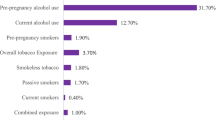Abstract
Canadian data on prenatal exposure to alcohol, tobacco, psychoactive drugs, and caffeine are sparse. This study presents prevalence rates in Saskatoon for these four risk behaviours during the first trimester of pregnancy and their associations with sociodemographic factors. Personal interviews were conducted with 605 pregnant women (83% participation rate). The most commonly used substance was caffeine (87%), followed by alcohol (46%), tobacco (30%), and psychoactive drugs (7%). Overall, 36% of women reported using two substances, 16% three, and 4% all four substances. In general, risk behaviours were more prevalent among women with lower education and income levels, Aboriginal or Métis background, those not living with a partner, those with previous births, and, in some cases, younger women. The findings illuminate the needs of particular groups of pregnant women and the importance of understanding maternal risk behaviour within the structural and cultural realities of women’s lives.
Résumé
Il y a peu de données sur l’exposition prénatale à l’alcool, au tabac, aux médicaments psychotropes et à la caféine au Canada. Cette étude présente les taux courants de prévalence à Saskatoon de ces quatre comportements à risque pendant le premier trimestre de la grossesse et leurs associations aux facteurs sociodémographiques. Des données ont été recueillies auprès de 605 femmes enceintes (taux de participation de 83 %) à l’aide d’entretiens personnels. La caféine était le produit le plus utilisé (87 %), suivi par l’alcool (46 %), le tabac (30 %), et les médicaments psychotropes (7 %). En tout, 36 % des femmes ont admis l’utilisation de deux de ces produits, 16 % de trois et 4 % de tous les quatre. En général ces comportements à haut risque sont plus répandus parmi les femmes avec de bas niveaux de scolarité et de revenu, d’origine autochtone ou Métis, ne vivant pas avec un partenaire, ayant eu des accouchements et, dans certains cas, d’un jeune âge. Ces résultats font ressortir les besoins de certains groupes de femmes enceintes et l’importance de comprendre le comportement à haut risque des mères à travers les réalités structurelles et culturelles de la vie des femmes.
Similar content being viewed by others
References
Kline J, Stein ZA, Susser M, et al. Smoking: A risk factor for spontaneous abortions. N Engl J Med 1977;297:793–96.
Shiono PH, Klebanoff MA, Rhoads, GG. Smoking and drinking during pregnancy: Their effects of preterm birth. JAMA 1986:255:82–84.
Kleinman JC, Madans, JH. The effects of maternal smoking, physical stature, and educational attainment on the incidence of low birth weight. Am J Epidemiol 1985;121:843–55.
Hebel JR, Fox NL, Sexon M. Dose-response of birth weight to various measures of maternal smoking during pregnancy. J Clin Epidemiol 1988;41:483–89.
Cnattingius S, Haglund B, Meirik O. Cigarette smoking as risk factor for late fetal and early neonatal death. BMJ 1988;297:258–61.
Wilcox A. Birth weight and perinatal mortality: The effects of maternal smoking. Am J Epidemiol 1993;137:1098–1104.
Kelsey JL, Dwyer T, Holford TR, et al. Maternal smoking habits and congenital malformations: An epidemiological study. J Epidemiol Community Health 1978;32:102–7.
Hingson R, Alpert JJ, Day N, et al. Effects of maternal drinking and marijuana use on fetal growth and development. Pediatrics 1982;70:539–46.
Day N, Jasperse D, Richardson G, et al. Prenatal exposure to alcohol: Effects on infant growth and morphologic characteristics. Pediatrics 1989;84:536–41.
Fried PA, O’Connell, CM. A comparison of the effects of prenatal exposure to tobacco, alcohol, cannabis and caffeine on birth size and subsequent growth. Neurotoxicol Teratol 1987;9:79–85.
Coles CD, Platzman KA, Smith IE, et al. Effects of cocaine and alcohol use in pregnancy on neonatal growth and neurobehavioural status. Neurotoxicol Teratol 1992;14:23–33.
Bell Woodard G, Edouard L. Reaching out: A community initiative for disadvantaged pregnant women. Can J Public Health 1992;83:188–95.
Lwanga SK, Lemeshow S. Sample Size Determination in Health Studies. A Practical Manual. Geneva: World Health Organization, 1991.
Wicks J, de Almeida J. MaCati 2. CAPI/DMS versions. Macintosh Assisted Personal Interviewing and Disk-by-Mail Survey System. Bowling Green, OH: Senecio Software Inc., 1993.
Day NL, Robles N. Methodological issues in the measurement of substance use. Ann NY Acad Sci 1989;562:8–13.
Stephens T, Fowler Graham D. Overview. In: Health and Welfare Canada, Stephens T, Fowler Graham D (Eds.), Canada’s Health Promotion Survey 1990: Technical Report. Ottawa: Minister of Supply and Services, 1993;4–7.
Hosmer DW, Lemeshow S. Applied Logistic Regression. New York, NY: John Wiley & Sons, 1989.
Stewart PJ, Potter J, Dulberg C, et al. Change in smoking prevalence among pregnant women 1982–93. Can J Public Health 1995;86:37–41.
Dodds L. Prevalence of smoking among pregnant women in Nova Scotia from 1988 to 1992. Can Med Assoc J 1995;152:185–90.
Fortier I, Marcoux S, Beaulac-Baillargeon L. Relation of caffeine intake during pregnancy to intrauterine growth retardation and preterm birth. Am J Epidemiol 1993;137:931–40.
Fried PA, Watkinson B, Grant A, et al. Changing patterns of soft drug use prior to and during pregnancy: A prospective study. Drug Alcohol Depend 1980;6:323–43.
Day NL, Sambamoorthi U, Taylor P, et al. Prenatal marijuana use and neonatal outcome. Neurotoxicol Teratol 1991;13:329–34.
Zuckerman B, Frank DA, Hingson R, et al. Effects of maternal marijuana and cocaine use on fetal growth. N Engl J Med 1989;320:762–68.
Author information
Authors and Affiliations
Corresponding authors
Additional information
This paper is based on a project initially funded by the Health Services Utilization and Research Commission, Saskatchewan, and continued with support from the National Health Research and Development Program (NHRDP), Health Canada. Dr. Muhajarine wishes to acknowledge the support of a National PhD fellowship from NHRDP, Health Canada.
Rights and permissions
About this article
Cite this article
Muhajarine, N., D’Arcy, C. & Edouard, L. Prevalence and Predictors of Health Risk Behaviours During Early Pregnancy: Saskatoon Pregnancy and Health Study. Can J Public Health 88, 375–379 (1997). https://doi.org/10.1007/BF03403909
Received:
Accepted:
Published:
Issue Date:
DOI: https://doi.org/10.1007/BF03403909




